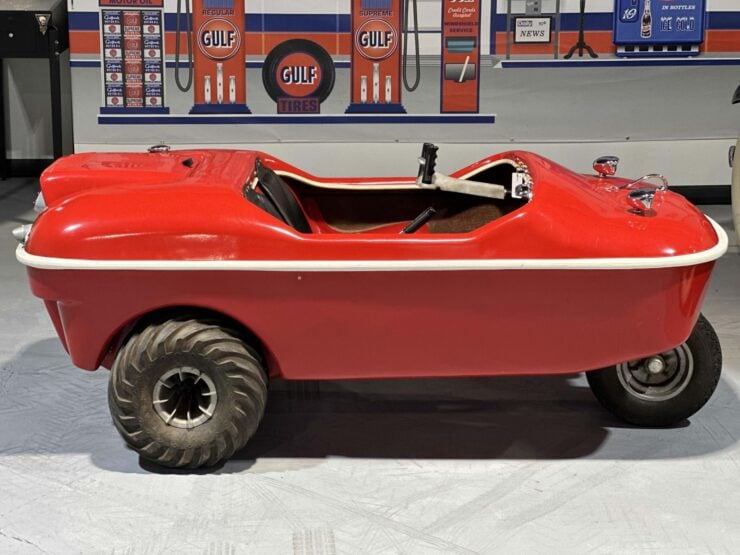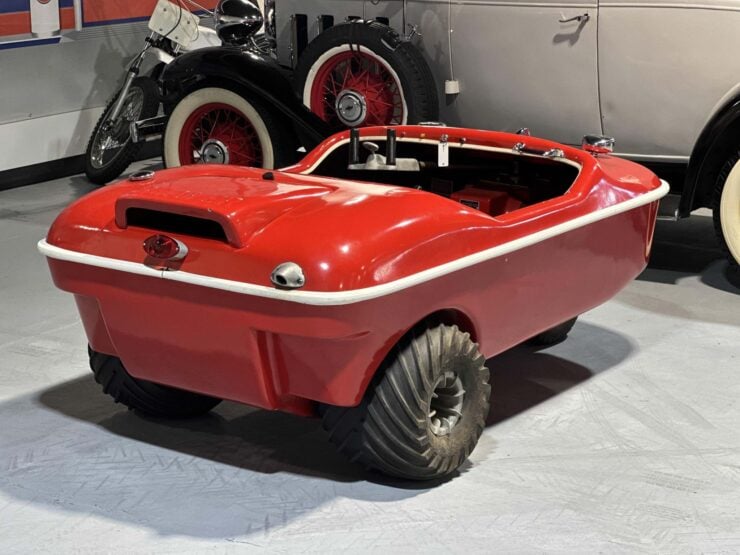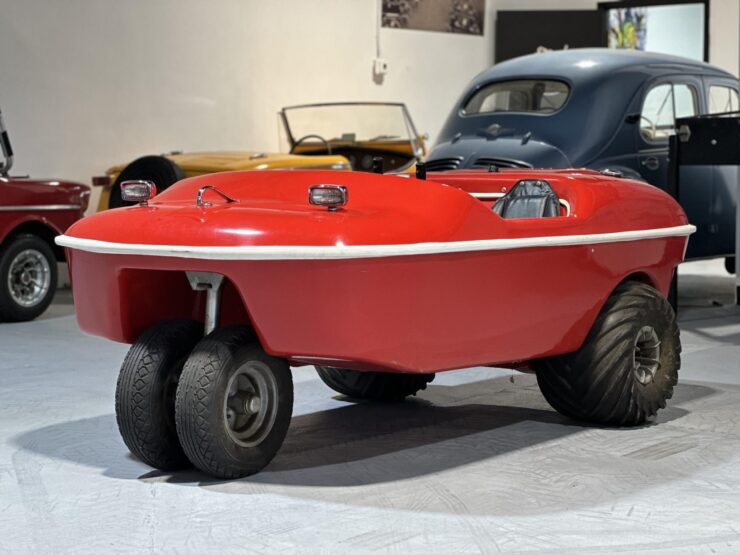This is a 1967 “Wheeler Beaver,” it’s an amphibious all-terrain vehicle (ATV) designed and built in Ontario, Canada with a fiberglass body/hull, seating for two, and a two-stroke engine sending power to the rear wheels via a 4-speed transmission.
The Beaver, and its predecessor the Penguin, were very early amphibious ATV designs. They proved highly-capable and were popular in Canada and the Northern United States, where the wilderness terrain made them an ideal off-road vehicle choice for many.
Fast Facts – The “Wheeler Beaver” Amphibious ATV
- This 1967 Wheeler Beaver is an amphibious all-terrain vehicle (ATV) with a fiberglass body, seating for two, and a two-stroke engine powering the rear wheels through a 4-speed transmission. Originally built in Ontario, Canada, it was popular for use on rugged terrain across Canada and the northern United States.
- The Beaver’s predecessor, the Penguin, was designed by Pengor Ltd in the early 1960s. Its simple, reliable design and amphibious capabilities made it a sought-after vehicle, and 800 or so were sold. After Pengor’s bankruptcy, the design was modified and reintroduced as the Beaver by Wheeler Mobile Ltd, with production continuing until around 1970.
- The Beaver is similar to the Penguin but with a modified front wheel arrangement. Few examples of either vehicle have survived, but a growing community of enthusiasts collects and restores these early amphibious ATVs, exchanging tips on maintenance and keeping them functional.
- This 1967 Wheeler Beaver is listed for sale in Boca Raton, Florida, on Bring a Trailer with no reserve price. The vehicle appears to be in good condition, running with a 175cc two-stroke engine, although the listing does not confirm if it is fully operational. It is offered for off-road use only.
The Penguin And The Beaver: A History Speedrun
The Penguin was developed in Toronto in the early 1960s, most sources agree that it was 1962 however some development work may have occurred earlier than this in 1961. It was developed by the engineers at Pengor Ltd and manufacturing began in 1963 at a small factory in Ottawa.


The design of the Penguin was kept simple to ensure that it would be reliable and easy for owners to work on themselves. The body of the vehicle was also a watertight hull, all made from fiberglass in two major parts, the lower tub and the upper tub which were joined at the belt line with a rub rail.
Inside you will find seating for two, with yoke-style steering on the left side, and there is a gear shifter in the center with a motorcycle-style clutch lever.
Power is provided by a two-stroke, single-cylinder engine, with both 197cc or 173cc Villiers engines offered. The engine is mated to a 4-speed transmission which powers the rear wheels via a chain final drive, and a single drum brake is fitted to the aft axle.
A top speed on land, on a flat paved surface presumably, was listed at 40 mph or 64 km/h. On the water the Penguin relied on the tread pattern of the rear wheels for propulsion, and so the top speed was 4 mph or 3.5 knots.
Although Pengor Ltd managed to sell approximately 800 examples of the Penguin, the company filed for bankruptcy in 1964, and in 1965 the company assets were sold off. The engineers at Pengor moved to a company called Bolens, and production of the Penguin resumed as the Bolens Penguin, however a factory fire killed off this company in 1967.


This wouldn’t quite be the end of the Penguin design, as a company named Wheeler Mobile Ltd of Keswick, Ontario would buy the rights and modify it slightly, moving the two front wheels together under the center of the hull.
This new vehicle would be called the Beaver and it would enter production in 1967 and remain in production until at least 1970. It’s not known exactly how many were built, but apart from the different wheel arrangement at the front the vehicle was essentially the same as the earlier Penguin.
Only a handful of either design have survived to the modern day, and there is a growing community of enthusiasts of early ATV and amphibious vehicles that collect and restore them, and exchange tips and advice on restoring them, and keeping them functioning.
The 1967 Wheeler Beaver Shown Here
The vehicle you see here is a Beaver from 1967, the first year of production under the ownership of Wheeler Mobile Ltd. It appears to be in surprisingly good condition throughout and it’s powered by the 175cc version of the air-cooled, two-stroke, single-cylinder engine.
The engine does run and the steering works, although the listing doesn’t mention if it’s fully-functional, it does appear to be. We only see these come up for sale very rarely, so this could be a rare opportunity to buy one if you happen to be in the market for a quirky vintage amphibian.
It’s now being offered for sale out of Boca Raton, Florida on Bring a Trailer with no reserve price, for off-road use only with a bill of sale. If you’d like to read more about it or register to bid you can visit the listing here.















Images courtesy of Bring a Trailer









